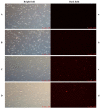Effects on Cell Membrane Integrity of Pichia anomala by the Accumulating Excessive Reactive Oxygen Species under Ethanol Stress
- PMID: 36429336
- PMCID: PMC9689904
- DOI: 10.3390/foods11223744
Effects on Cell Membrane Integrity of Pichia anomala by the Accumulating Excessive Reactive Oxygen Species under Ethanol Stress
Abstract
Ethanol stress to yeast is well recognized and exists widely during the brewing process of alcohol products. Pichia anomala is an important ester-producing yeast in the brewing process of Chinese Baijiu and other alcohol products. Therefore, it is of great significance for the alcohol products brewing industry to explore the effects of ethanol stress on the growth metabolism of P. anomala. In this study, the effects of ethanol stress on the growth, esters production ability, cell membrane integrity and reactive oxygen species (ROS) metabolism of P. anomala NCU003 were studied. Our results showed that ethanol stress could inhibit the growth, reduce the ability of non-ethyl ester compounds production and destroy the cell morphology of P. anomala NCU003. The results also showed that 9% ethanol stress produced excessive ROS and then increased the activities of antioxidant enzymes (superoxide dismutase, catalase, aseorbateperoxidase and glutathione reductase) compared to the control group. However, these increased antioxidant enzyme activities could not prevent the damage caused by ROS to P. anomala NCU003. Of note, correlation results indicated that high content of ROS could promote the accumulation of malondialdehyde content, resulting in destruction of the integrity of the cell membrane and leading to the leakage of intracellular nutrients (soluble sugar and protein) and electrolytes. These results indicated that the growth and the non-ethyl ester compounds production ability of P. anomala could be inhibited under ethanol stress by accumulating excessive ROS and the destruction of cell membrane integrity in P. anomala.
Keywords: Pichia anomala; cell membrane integrity; ester production ability; ethanol stress; reactive oxygen species.
Conflict of interest statement
The authors declare no conflict of interest.
Figures







References
-
- Liu C.F., Li M.X., Ren T., Wang J.J., Niu C.T., Zheng F.Y., Li Q. Effect of Saccharomyces cerevisiae and non-Saccharomyces strains on alcoholic fermentation behavior and aroma profile of yellow-fleshed peach wine. LWT-Food Sci. Technol. 2022;155:112993. doi: 10.1016/j.lwt.2021.112993. - DOI
-
- Lv X.C., Jiang Y.J., Liu J., Guo W.L., Liu Z.B., Zhang W., Rao P.F., Ni L. Evaluation of different PCR primers for denaturing gradient gel electrophoresis (DGGE) analysis of fungal community structure in traditional fermentation starters used for Hong Qu glutinous rice wine. Int. J. Food Microbiol. 2017;255:58–65. doi: 10.1016/j.ijfoodmicro.2017.05.010. - DOI - PubMed
Grants and funding
LinkOut - more resources
Full Text Sources

